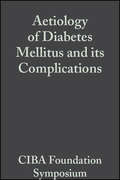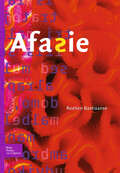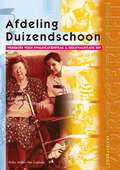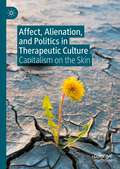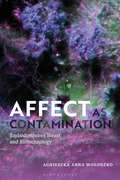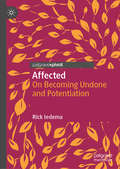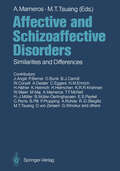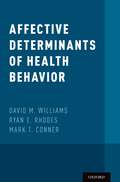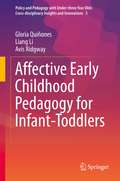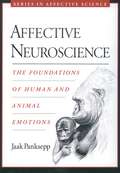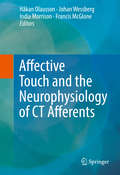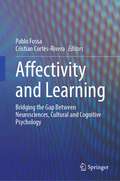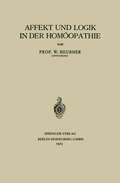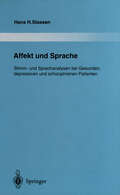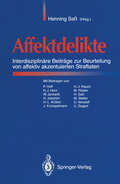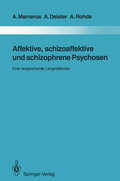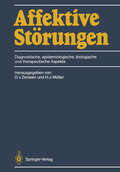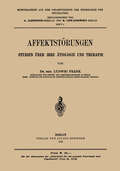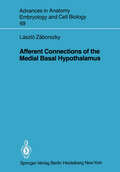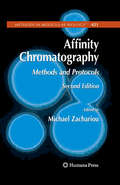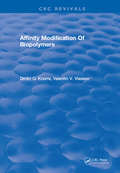- Table View
- List View
Aetiology of Diabetes Mellitus and its Complications, Volume 15: Colloquia on Endocrinology (Novartis Foundation Symposia #960)
by Margaret P. Cameron Maeve O'ConnorThe Novartis Foundation Series is a popular collection of the proceedings from Novartis Foundation Symposia, in which groups of leading scientists from a range of topics across biology, chemistry and medicine assembled to present papers and discuss results. The Novartis Foundation, originally known as the Ciba Foundation, is well known to scientists and clinicians around the world.
Afasie
by Roelien BastiaanseAfasie is een taalstoornis ten gevolge van hersenletsel, bijvoorbeeld na een beroerte. Iemand die lijdt aan afasie kan niet meer normaal over zijn taalvermogen beschikken en zal daardoor communicatieproblemen ondervinden die niet alleen grote gevolgen hebben voor de patiënt zelf, maar ook voor zijn omgeving. Verschillende disciplines hebben te maken met afasie. Logopedisten en klinisch linguïsten zijn verantwoordelijk voor de diagnostiek en de therapie. Neurologen en revalidatie-artsen zullen niet zelden patiënten zien die aan afasie lijden. Afasie biedt echter ook een blik op de taalverwerkingsprocessen in de hersenen en wordt als zodanig bestudeerd door neurolinguïsten en neuropsychologen. Zij analyseren wat de patiënten wel en niet kunnen en proberen daar patronen in te ontdekken. Zo willen zij inzicht krijgen in de representatie van taal in de hersenen. In dit boek worden de oorzaken van afasie, de symptomen en de afasiesyndromen beschreven. Ook wordt er een historisch beeld geschetst van de ontwikkeling van het vakgebied en komen wetenschappelijke ontwikkelingen aan bod. Een samenhangend overzicht wordt gegeven van het klinische en wetenschappelijke onderzoek naar afasie.
Afdeling Duizendschoon: Werkboek voor kwalificatieniveau 3, deelkwalificatie 309 (Zorggericht)
by J.C.J. Korhorn W.M. de Vries-PrinsZorgcategorie: Geriatrische zorgvrager Setting: WoonzorgcentrumKorte inhoud: De afdeling Duizendschoon is een afdeling in een verpleeghuis. De bewoners hebben psychogeriatrische problemen. Ze kunnen niet meer thuis wonen. Bij een blijvende opname wordt de woning verkocht of de huur opgezegd en alle eigendommen en meubels worden door de familie weggedaan. De verpleegafdeling is echt de laatste woonplaats. De mensen die op een psychogeriatrische afdeling in dit verpleeg- huis wonen delen hun kamer met drie andere mensen. Het enige dat zij nog voor zichzelf hebben is een bed, een kledingkast en een nachtkastje. En daarvan kunnen zij niet onthouden dat het van hen is, als ze dement zijn.
Affect, Alienation, and Politics in Therapeutic Culture: Capitalism on the Skin
by Suvi SalmenniemiThis book contributes to research on therapeutic culture by drawing on longstanding ethnographic work and by offering a new theoretical reading of therapeutic culture in today's society. It suggests that the therapeutic field serves as a key site in which a number of contradictions of capitalism are confronted and lived out. It shows that therapeutic engagements are inherently ambivalent and contradictory, as they can be articulated and engaged with in many different ways and harnessed for diverse, and often contradictory, political projects. The book takes issue with the interpretation of therapeutic culture as merely individualising, depoliticizing and working in congruence with neoliberalism, and shows that therapeutic engagements may also open up a space for contestation and critique of neoliberal capitalism, animate collective action for social change and articulate alternative forms of life and subjectivities. The book will speak to a wide variety of audiences in the social sciences and will be of particular interest to those working in the fields of sociology, anthropology, critical psychology, cultural studies, gender studies, and critical social theory.
Affect as Contamination: Embodiment in Bioart and Biotechnology
by Agnieszka WolodzkoBringing the concept of contamination into dialogue with affect theory and bioart, Agnieszka Wolodzko urges us to rethink our relationship with ourselves, each other and other organisms. Thinking through the lens of contamination, this book provides an innovative approach to understanding the leaky, porous and visceral nature of our bodies and their endless interrelationships and, in doing so, uncovers new ways for thinking about embodiment. Affect theory has long been interested in transmission or contagion but, inspired by Spinoza and Deleuze, Affect as Contamination goes further, as contamination is concerned with the materiality of bodies and their affective encounter with other matter. This brings urgency to the notion of affect, not only for bioart that works with risky bodies but also for understanding how to practise our bodies in the age of biotechnological manipulation and governance. Using challenging and transgressive bioart projects as provocative case studies for rethinking affect and bodily practice, Wolodzko follows various 'contaminants' from blood, hormones and viruses to food, glitter and plants. This takes the form of both personal accounts of encounters with the contaminations of bioart and critical analyses of aesthetic, material and technical objects, with each one highlighting in different ways the risky and uncertain nature of contamination. Affect as Contamination is an urgent and original meditation on just what it means to be living, and practising our bodies, in an era where biotechnology contaminates all aspects of our lives.
Affect as Contamination: Embodiment in Bioart and Biotechnology
by Agnieszka WolodzkoBringing the concept of contamination into dialogue with affect theory and bioart, Agnieszka Wolodzko urges us to rethink our relationship with ourselves, each other and other organisms. Thinking through the lens of contamination, this book provides an innovative approach to understanding the leaky, porous and visceral nature of our bodies and their endless interrelationships and, in doing so, uncovers new ways for thinking about embodiment. Affect theory has long been interested in transmission or contagion but, inspired by Spinoza and Deleuze, Affect as Contamination goes further, as contamination is concerned with the materiality of bodies and their affective encounter with other matter. This brings urgency to the notion of affect, not only for bioart that works with risky bodies but also for understanding how to practise our bodies in the age of biotechnological manipulation and governance. Using challenging and transgressive bioart projects as provocative case studies for rethinking affect and bodily practice, Wolodzko follows various 'contaminants' from blood, hormones and viruses to food, glitter and plants. This takes the form of both personal accounts of encounters with the contaminations of bioart and critical analyses of aesthetic, material and technical objects, with each one highlighting in different ways the risky and uncertain nature of contamination. Affect as Contamination is an urgent and original meditation on just what it means to be living, and practising our bodies, in an era where biotechnology contaminates all aspects of our lives.
Affected: On Becoming Undone and Potentiation
by Rick IedemaThis book’s main message is to advocate for a collaborative, affective, visualised and future-oriented research agenda. The book finds its inspiration in “the chasm [that separates] philosophising about being shattered and thinking that is shattered” (Heidegger 1946, Letter on Humanism). To explore this chasm, the book journeys through a range of psychological and posthuman perspectives on affect and becoming. The aim of this journey is to reconcile shattered thinking-feeling with Spinoza’s ethics according to which ‘our capacity to be affected determines our capacity to act’. The book elaborates this capacity to become in terms of our uniquely human propensity to experiment with counter-intuitive inversions: in this case, to call to account that which is affected, rather than that which affects. The book will appeal to students and academics working in the fields of alternative research methods, the social sciences, and organisation studies.
Affective and Schizoaffective Disorders: Similarities and Differences
by J. Angst P. Berner D. Bunk B. J. Carroll W. Coryell A. Deister C. Eggers H. M. Emrich H. Häfner K. Heinrich H. Helmchen K.R.R. Krishnan W. Maier M. Maj A. Marneros T. F. McNeil H. J. Möller B. Müller-Oerlinghausen E. S. Paykel C. Perris B. Pitt P. Propping A. Rohde R. D. Stieglitz M. T. Tsuang D. Von Zerssen G. WinokurSeveral contributions in our first book about schizo affective disorders (Marneros and Tsuang, Schizoaffective Psychoses, Springer-Verlag, 1986) supported the assumption that schizoaffective disorders differ in relevant ways from schizophrenic disorders. The classification of schizo affective disorders as a subgroup of schizophrenia has also been criticized, and empirical research in clinical, genetic, therapeutic, and prognostic areas supports the idea that there are some strong similari ties between schizo affective and affective disorders. Of course, there are not only similarities between these two groups, but also differences just as there are between schizo affective and schizophrenic disorders. It is precisely the existence of similarities and differences between schizo affective disorders and the other two so-called typical mental disorders, i.e., schizophrenia and affective disorders, which makes them a challenge in psychiatric research, a challenge to the traditional dichotomy in the classification of disorders which originated with Kraepelin. This challenge is certainly proving fruitful in psychiatric research. These "cases in between" may well demonstrate that sep arating, dividing, and limiting is not always meaningful. Sometimes it can be more meaningful to unify; to unify in the sense of building bridges between typical groups. It is here that the assumption of a "psychotic continuum" can become relevant, and the investigation of schizoaffective disorders is of prime importance in research on a possible continuum of psychosis.
Affective Determinants of Health Behavior
by David M. Williams, Ryan E. Rhodes and Mark T. ConnerIn the last 20-30 years, research on affective determinants of health behavior has proliferated. Affective Determinants of Health Behavior brings together this burgeoning area of research into a single volume and features contributions from leading experts in their respective areas. Editors David M. Williams, Ryan E. Rhodes, and Mark T. Conner and their contributing authors focus on a fascinating range of affective concepts, including (but not limited to) hedonic response, incidental affect, perceived satisfaction, anticipated affect, affective attitudes, and affective associations. In the first part of the book, the role of affective concepts in multiple theories of health behavior is highlighted and expanded, including theories of action control, dual-processing, temporal self-regulation, self-determination, and planned behavior, along with a new theory of hedonic motivation. The second part of the book focuses on the role of affective concepts in specific health behavior domains, including physical activity, eating, smoking, substance use, sex, tanning, blood donation, the performance of health professionals, cancer screenings, and cancer control. Affective Determinants of Health Behavior offers readers an important window into existing research and serves as a showcase for important insights on possible new directions and implications for intervention.
Affective Determinants of Health Behavior
In the last 20-30 years, research on affective determinants of health behavior has proliferated. Affective Determinants of Health Behavior brings together this burgeoning area of research into a single volume and features contributions from leading experts in their respective areas. Editors David M. Williams, Ryan E. Rhodes, and Mark T. Conner and their contributing authors focus on a fascinating range of affective concepts, including (but not limited to) hedonic response, incidental affect, perceived satisfaction, anticipated affect, affective attitudes, and affective associations. In the first part of the book, the role of affective concepts in multiple theories of health behavior is highlighted and expanded, including theories of action control, dual-processing, temporal self-regulation, self-determination, and planned behavior, along with a new theory of hedonic motivation. The second part of the book focuses on the role of affective concepts in specific health behavior domains, including physical activity, eating, smoking, substance use, sex, tanning, blood donation, the performance of health professionals, cancer screenings, and cancer control. Affective Determinants of Health Behavior offers readers an important window into existing research and serves as a showcase for important insights on possible new directions and implications for intervention.
Affective Early Childhood Pedagogy for Infant-Toddlers (Policy and Pedagogy with Under-three Year Olds: Cross-disciplinary Insights and Innovations #3)
by Gloria Quiñones Liang Li Avis RidgwayThis exciting new book brings fresh knowledge of affective pedagogies in early childhood education and care. The book draws on cultural-historical theory in alignment with visual methodologies to elucidate infant-toddlers’ affective pedagogies through analysis of case examples. The book reveals contemporary pedagogical practices in the infant-toddler space like mealtimes, nappy change and play. These pedagogical practices show the highly specialised nature of working with infant-toddlers such as the affective relations between educators and infant-toddlers, affective dialogue, affective engagement, and the creation of affective spaces. The value of collaboration is highlighted through creating an affective space for educators to become aware, reflect and position themselves as effective and affective educators. The book introduces innovative methodological tools such as images and collective drawings for collaborative reflection.
Affective Neuroscience: The Foundations of Human and Animal Emotions (Series in Affective Science)
by Jaak PankseppSome investigators have argued that emotions, especially animal emotions, are illusory concepts outside the realm of scientific inquiry. However, with advances in neurobiology and neuroscience, researchers are demonstrating that this position is wrong as they move closer to a lasting understanding of the biology and psychology of emotion. In Affective Neuroscience, Jaak Panksepp provides the most up-to-date information about the brain-operating systems that organize the fundamental emotional tendencies of all mammals. Presenting complex material in a readable manner, the book offers a comprehensive summary of the fundamental neural sources of human and animal feelings, as well as a conceptual framework for studying emotional systems of the brain. Panksepp approaches emotions from the perspective of basic emotion theory but does not fail to address the complex issues raised by constructionist approaches. These issues include relations to human consciousness and the psychiatric implications of this knowledge. The book includes chapters on sleep and arousal, pleasure and fear systems, the sources of rage and anger, and the neural control of sexuality, as well as the more subtle emotions related to maternal care, social loss, and playfulness. Representing a synthetic integration of vast amounts of neurobehavioral knowledge, including relevant neuroanatomy, neurophysiology, and neurochemistry, this book will be one of the most important contributions to understanding the biology of emotions since Darwins The Expression of the Emotions in Man and Animals
Affective Neuroscience: The Foundations of Human and Animal Emotions (Series in Affective Science)
by Jaak PankseppSome investigators have argued that emotions, especially animal emotions, are illusory concepts outside the realm of scientific inquiry. However, with advances in neurobiology and neuroscience, researchers are demonstrating that this position is wrong as they move closer to a lasting understanding of the biology and psychology of emotion. In Affective Neuroscience, Jaak Panksepp provides the most up-to-date information about the brain-operating systems that organize the fundamental emotional tendencies of all mammals. Presenting complex material in a readable manner, the book offers a comprehensive summary of the fundamental neural sources of human and animal feelings, as well as a conceptual framework for studying emotional systems of the brain. Panksepp approaches emotions from the perspective of basic emotion theory but does not fail to address the complex issues raised by constructionist approaches. These issues include relations to human consciousness and the psychiatric implications of this knowledge. The book includes chapters on sleep and arousal, pleasure and fear systems, the sources of rage and anger, and the neural control of sexuality, as well as the more subtle emotions related to maternal care, social loss, and playfulness. Representing a synthetic integration of vast amounts of neurobehavioral knowledge, including relevant neuroanatomy, neurophysiology, and neurochemistry, this book will be one of the most important contributions to understanding the biology of emotions since Darwins The Expression of the Emotions in Man and Animals
Affective Touch and the Neurophysiology of CT Afferents
by Håkan Olausson Johan Wessberg India Morrison Francis McGloneCT afferents are receptors in mammalian hairy skin that fire action potentials when the skin is touched lightly which makes them particularly important in affective touch. Traditionally neuroscientific research has focused on more discriminative and haptic properties of touch that are mediated by large myelinated afferents and the coding properties and functional organization of unmyelinated CT afferents have been studied much less. The proposed volume will draw together existing knowledge in this nascent field. Separate sections will address (1) how we can measure affective touch, (2) CT structure and physiology, (3) CT processing, (4) the contribution of CTs to sexual behavior, (5) clinical relevance, (6) commercial relevance, and (7) future research considerations.
Affectivity and Learning: Bridging the Gap Between Neurosciences, Cultural and Cognitive Psychology
by Pablo Fossa Cristian Cortés-RiveraThis book presents an interdisciplinary approach to the study of affectivity and human learning by bridging the gap between neuroscience, cultural and cognitive psychology. It brings together studies that go beyond the focus on cognitive-intellectual variables involved in learning processes and incorporate the study of the role played by affectivity and emotions in learning not only at educational settings but in all processes of transformation and human development, thus presenting affectivity as a catalyst and mediator of all daily learning processes.Chapters brought together in this contributed volume present both theoretical contributions and results of empirical research from different disciplines, such as neuroscience, cognitive psychology, cultural psychology, educational psychology, developmental psychology and philosophy, and are grouped into five thematic sections. The first part of the book brings together chapters discussing different aspects of the role played by affectivity in learning processes from the perspectives of cultural, educational and developmental psychology. The second part is dedicated to the role of affectivity for teachers during their training as educators and during their pedagogical practice in diverse contexts. The third part focuses on the relationship between affectivity and learning from a neuroscientific point of view. The fourth part discusses affectivity and learning in therapeutic and clinical contexts. Finally, the fifth part brings together chapters about affectivity and learning in everyday life.By bringing together this rich interdisciplinary collection of studies, Affectivity and Learning: Bridging the Gap Between Neurosciences, Cultural and Cognitive Psychology will be a valuable resource for researchers in the fields of psychology, neuroscience and education, as well as for educators and teachers interested in knowing more about the relationship between affectivity and human learning.
Affekt und Logik in der Homöopathie (Fachbücher für Ärzte)
by W. HeubnerDieser Buchtitel ist Teil des Digitalisierungsprojekts Springer Book Archives mit Publikationen, die seit den Anfängen des Verlags von 1842 erschienen sind. Der Verlag stellt mit diesem Archiv Quellen für die historische wie auch die disziplingeschichtliche Forschung zur Verfügung, die jeweils im historischen Kontext betrachtet werden müssen. Dieser Titel erschien in der Zeit vor 1945 und wird daher in seiner zeittypischen politisch-ideologischen Ausrichtung vom Verlag nicht beworben.
Affekt und Sprache: Stimm- und Sprachanalysen bei Gesunden, depressiven und schizophrenen Patienten (Monographien aus dem Gesamtgebiete der Psychiatrie #79)
by Hans H. StassenDie meisten Zuhörer verstehen intuitiv, wenn ein Gesprächspartner durch Sprechweise und Tonfall Teile des Gesprochenen verstärkt oder, unabhängig vom verbalen Inhalt des Gesprochenen, seine Intentionen oder seinen Gemütszustand signalisiert. In der Psychiatrie sind deshalb Sprechweise und Klangfarbe der Stimme wichtige Informationsquellen, wenn es darum geht, die Schwere einer affektiven Erkrankung oder Veränderung im Zustandsbild eines Patienten klinisch einzuschätzen. Das Buch bietet eine Fülle normativer Daten, die in Tabellen und Abbildungen zusammengefaßt sind. Der Leser erhält zudem wichtige Informationen, die die praktische Anwendung von Sprachanalysen in Klinik und Forschung erleichtern.
Affektdelikte: Interdisziplinäre Beiträge zur Beurteilung von affektiv akzentuierten Straftaten
by Henning SaßErstmals behandeln führende Vertreter der forensischen Wissenschaftszweige - Strafrechtler, Psychiater und Psychologen, Anwälte, Rechtsmediziner - interdisziplinär die Problemgeschichte, den gegenwärtigen Diskussionsstand und mögliche Lösungsansätze für die Beurteilung von Schuldfähigkeit bei Affektdelikten.Die Frage von Schuld, Schuldfähigkeit und Strafe wird aus unterschiedlicher Perspektive und mit durchaus divergierenden Auffassungen diskutiert.Das Buch ist aufschlußreich für jeden, der sich wissenschaftlich, als Gutachter oder in der gerichtlichen Praxis mit der Frage von Bewußtseinsveränderungen durch heftige Gemütserregung und mit Affektdelikten auseinandersetzen muß.
Affektive, schizoaffektive und schizophrene Psychosen: Eine vergleichende Langzeitstudie (Monographien aus dem Gesamtgebiete der Psychiatrie #65)
by Andreas Marneros Arno Deister Anke RohdeAffektive Störungen: Diagnostische, epidemiologische, biologische und therapeutische Aspekte
by Detlev V. Zerssen Hans-Jürgen MöllerDer Begriff "affektive Störungen" fehlt bisher in den deutschsprachigen psychiatrischen Lehr- und Handbüchern. Das Buch vermittelt Ärzten und klinischen Psychologen einen umfassenden Überblick über den aktuellen Wissensstand der affektiven Störungen, also Krankheitsbilder, die in ihrem gesamten Verlauf durch das Vorherrschen von Affektstörungen vornehmlich manischer, depressiver oder ängstlicher Färbung geprägt sind. Die Probleme der Klassifikation und Erfassung affektiver Störungen werden ebenso beschrieben wie ihre Verbreitung in der Bevölkerung und ihr Verlauf bei behandelten und unbehandelten Fällen unter besonderer Berücksichtigung von Risikofaktoren. Daneben werden die hormonelle Regulation und die Schlafphysiologie angesprochen sowie pharmakologische und psychologische Behandlungsansätze und ihre theoretischen Grundlagen. Das Buch vermittelt dem Leser den neuesten Erkenntnisstand auf diesem Gebiet und will ihn durch Herausarbeitung ungeklärter Fragen und durch Hinweise auf einschlägige Arbeiten zur intensiven Beschäftigung mit den Problemen der affektiven Störungen sowie den Möglichkeiten angemessener Hilfsmaßnahmen für den von ihnen Betroffenen anregen.
Affektstörungen Studien über Ihre ätiologie und Therapie: Heft 4 (Monographien aus dem Gesamtgebiete der Neurologie und Psychiatrie #4)
by Ludwig FrankDieser Buchtitel ist Teil des Digitalisierungsprojekts Springer Book Archives mit Publikationen, die seit den Anfängen des Verlags von 1842 erschienen sind. Der Verlag stellt mit diesem Archiv Quellen für die historische wie auch die disziplingeschichtliche Forschung zur Verfügung, die jeweils im historischen Kontext betrachtet werden müssen. Dieser Titel erschien in der Zeit vor 1945 und wird daher in seiner zeittypischen politisch-ideologischen Ausrichtung vom Verlag nicht beworben.
Afferent Connections of the Medial Basal Hypothalamus (Advances in Anatomy, Embryology and Cell Biology #69)
by Laszlo ZaborszkyAffinity Chromatography: Methods and Protocols (Methods in Molecular Biology #421)
by Michael ZachariouThirty-eight years after its introduction, affinity chromatography remains a key tool in the armory of separation techniques available to separation and interaction scientists. Expanded and updated from the first edition, this second edition volume aims to provide the beginner with the practical knowledge needed to develop affinity separations suitable for a variety of applications relevant to the post-genomic era. It contains state-of-the-art, brand new protocols, and provides step-by-step laboratory instructions for readily reproducible results.
Affinity Modification Of Biopolymers
by Dmitri G KnorreThe goal of this book is to give a systematic description of the main principles of affinity modification and applications, consideration of possibilities, and restrictions of the method. Modification within specific complexes is a special case of chemical modification which is widely used in the nonaddressed version in biochemistry and related areas. Therefore, we have included in the first introductory paper chapter of the book general considerations of chemical modifications of biopolymers and the application of biopolymers.
Affinity Modification Of Biopolymers
by Dmitri G KnorreThe goal of this book is to give a systematic description of the main principles of affinity modification and applications, consideration of possibilities, and restrictions of the method. Modification within specific complexes is a special case of chemical modification which is widely used in the nonaddressed version in biochemistry and related areas. Therefore, we have included in the first introductory paper chapter of the book general considerations of chemical modifications of biopolymers and the application of biopolymers.
